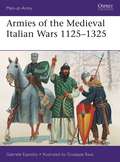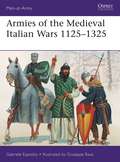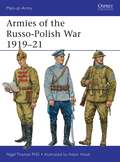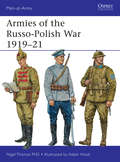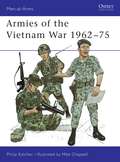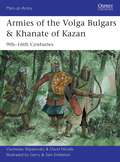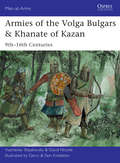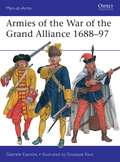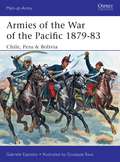- Table View
- List View
Armies of the Italian-Turkish War: Conquest of Libya, 1911–1912 (Men-at-Arms)
by Gabriele EspositoIn the early 1900s, the decaying Ottoman Turkish Empire had lost some of its Balkan territories, but still nominally ruled all of North Africa between British Egypt in the east and French Algeria in the west. Libya had fertile coastal territory, and was the last North African (almost, the last African) region not yet conquered by a European colonialist power. Italy was a young country, ambitious for colonies, but had been defeated in Ethiopia in the 1890s. The Italian government of Giovanni Giolitti was keen to overwrite the memory of that failure, and to gain a strategic grip over the central Mediterranean by seizing Libya, just across the narrows from Sicily. The Italian expeditionary force that landed in October 1911 easily defeated the Ottoman division based in the coastal cities, incurring few losses. However, the Libyan inland tribes reacted furiously to the Italian conquest, and their insurgency cost the Italians thousands of casualties, locking them into the coastal enclaves during a winter stalemate which diminished Italian public enthusiasm for the war. To retrieve Italian prestige the government launched a naval campaign in the Dardanelles and the Dodecanese – the last Turkish held archipelago in the Aegean – in April–May 1912, and landed troops to capture Rhodes. The army finally pushed inland in Libya in July– October (using systematic air reconnaissance, for the first time), and after brutal fighting the war ended in a treaty that brought Italy all it wanted, although though the Libyan tribes would not finally be quelled until after World War I. Containing accurate full-colour artwork and unrivalled detail, Armies of the Italian-Turkish War offers a vivid insight into the troops involved in this pivotal campaign, including the tribal insurgents and the navies of both sides.
Armies of the Italian-Turkish War: Conquest of Libya, 1911–1912 (Men-at-Arms #534)
by Gabriele EspositoIn the early 1900s, the decaying Ottoman Turkish Empire had lost some of its Balkan territories, but still nominally ruled all of North Africa between British Egypt in the east and French Algeria in the west. Libya had fertile coastal territory, and was the last North African (almost, the last African) region not yet conquered by a European colonialist power. Italy was a young country, ambitious for colonies, but had been defeated in Ethiopia in the 1890s. The Italian government of Giovanni Giolitti was keen to overwrite the memory of that failure, and to gain a strategic grip over the central Mediterranean by seizing Libya, just across the narrows from Sicily. The Italian expeditionary force that landed in October 1911 easily defeated the Ottoman division based in the coastal cities, incurring few losses. However, the Libyan inland tribes reacted furiously to the Italian conquest, and their insurgency cost the Italians thousands of casualties, locking them into the coastal enclaves during a winter stalemate which diminished Italian public enthusiasm for the war. To retrieve Italian prestige the government launched a naval campaign in the Dardanelles and the Dodecanese – the last Turkish held archipelago in the Aegean – in April–May 1912, and landed troops to capture Rhodes. The army finally pushed inland in Libya in July– October (using systematic air reconnaissance, for the first time), and after brutal fighting the war ended in a treaty that brought Italy all it wanted, although though the Libyan tribes would not finally be quelled until after World War I. Containing accurate full-colour artwork and unrivalled detail, Armies of the Italian-Turkish War offers a vivid insight into the troops involved in this pivotal campaign, including the tribal insurgents and the navies of both sides.
Armies of the Italian Wars of Unification 1848–70: Piedmont and the Two Sicilies (Men-at-Arms)
by Giuseppe Rava Gabriele EspositoIn the 1840s, post-Napoleonic Italy was 'a geographical expression' – not a country, but a patchwork of states, divided between the Austrian-occupied north, and a Spanish-descended Bourbon monarchy, who ruled the south from Naples. Two decades later, it was a nation united under a single king and government, thanks largely to the efforts of the Kings of Sardinia and Piedmont, and the revolutionary Giuseppe Garibaldi. This book, the first of a two-part series on the armies that fought in the Italian Wars of Unification, examines the Piedmontese and Neapolitan armies that fought in the north and south of the peninsula. Illustrated with prints, early photos and detailed commissioned artwork, this book explores the history, organization, and appearance of the armies that fought to unite the Italian peninsula under one flag.
Armies of the Italian Wars of Unification 1848–70: Papal States, Minor States & Volunteers (Men-at-Arms)
by Giuseppe Rava Gabriele EspositoIn the 1840s, Italy was a patchwork of states. The North was ruled by the Austrian Empire, the South by the Spanish-descended monarchy of the Two Sicilies. Over the next two decades, after wars led by Savoy/Piedmont and volunteers such as Garibaldi, an independent Kingdom of Italy emerged. These conflicts saw foreign interventions and shifting alliances among minor states, and attracted a variety of local and foreign volunteers. This second volume in a two part series covers the armies of the Papal States; the duchies of Tuscany, Parma, and Modena; the republics of Rome and San Marco (Venice) and the transitional Kingdom of Sicily; and the various volunteer movements. These varied armies and militias wore a wide variety of highly colourful uniforms which are brought to life in stunning, specially commissioned, full colour artwork from Giuseppe Rava.
Armies of the Italian Wars of Unification 1848–70: Papal States, Minor States & Volunteers (Men-at-Arms)
by Giuseppe Rava Gabriele EspositoIn the 1840s, Italy was a patchwork of states. The North was ruled by the Austrian Empire, the South by the Spanish-descended monarchy of the Two Sicilies. Over the next two decades, after wars led by Savoy/Piedmont and volunteers such as Garibaldi, an independent Kingdom of Italy emerged. These conflicts saw foreign interventions and shifting alliances among minor states, and attracted a variety of local and foreign volunteers. This second volume in a two part series covers the armies of the Papal States; the duchies of Tuscany, Parma, and Modena; the republics of Rome and San Marco (Venice) and the transitional Kingdom of Sicily; and the various volunteer movements. These varied armies and militias wore a wide variety of highly colourful uniforms which are brought to life in stunning, specially commissioned, full colour artwork from Giuseppe Rava.
Armies of the Italian Wars of Unification 1848–70: Piedmont and the Two Sicilies (Men-at-Arms #512)
by Giuseppe Rava Gabriele EspositoIn the 1840s, post-Napoleonic Italy was 'a geographical expression' – not a country, but a patchwork of states, divided between the Austrian-occupied north, and a Spanish-descended Bourbon monarchy, who ruled the south from Naples. Two decades later, it was a nation united under a single king and government, thanks largely to the efforts of the Kings of Sardinia and Piedmont, and the revolutionary Giuseppe Garibaldi. This book, the first of a two-part series on the armies that fought in the Italian Wars of Unification, examines the Piedmontese and Neapolitan armies that fought in the north and south of the peninsula. Illustrated with prints, early photos and detailed commissioned artwork, this book explores the history, organization, and appearance of the armies that fought to unite the Italian peninsula under one flag.
Armies of the Medieval Italian Wars 1125–1325 (Men-at-Arms #523)
by Giuseppe Rava Gabriele EspositoThe great powers of medieval Europe fought continuously in the Italian peninsula between the 12th and 14th centuries as they sought to expand their territory. Invading armies from Germany – the Holy Roman Empire – saw the creation of the defensive Lombard League of northern Italian city-states. These struggles resulted in conflicts between rival confederacies, which in turn proved to be the catalysts for developments in organisation and tactics. Italian urban militias became better organised and equipped, the Imperial armies went from being mostly German to multi-national forces, and both sides became reliant on mercenary forces to prosecute their wars. After the 1260s, France, relying mainly on armoured cavalry, and Spain, with their innovative light infantry, vied for control of southern Italy. On the seas, the great naval powers of Genoa, Pisa and Venice became fierce rivals, as they created great trading empires, bringing the treasures of the east into feudal Europe. Using detailed colour plates, this beautifully illustrated book describes the myriad of armies and navies that fought for control of Italy in the Middle Ages.
Armies of the Medieval Italian Wars 1125–1325 (Men-at-Arms #523)
by Giuseppe Rava Gabriele EspositoThe great powers of medieval Europe fought continuously in the Italian peninsula between the 12th and 14th centuries as they sought to expand their territory. Invading armies from Germany – the Holy Roman Empire – saw the creation of the defensive Lombard League of northern Italian city-states. These struggles resulted in conflicts between rival confederacies, which in turn proved to be the catalysts for developments in organisation and tactics. Italian urban militias became better organised and equipped, the Imperial armies went from being mostly German to multi-national forces, and both sides became reliant on mercenary forces to prosecute their wars. After the 1260s, France, relying mainly on armoured cavalry, and Spain, with their innovative light infantry, vied for control of southern Italy. On the seas, the great naval powers of Genoa, Pisa and Venice became fierce rivals, as they created great trading empires, bringing the treasures of the east into feudal Europe. Using detailed colour plates, this beautifully illustrated book describes the myriad of armies and navies that fought for control of Italy in the Middle Ages.
The Armies of the Night: History as a Novel / The Novel as History (Penguin Modern Classics #305)
by Norman MailerOctober 21, 1967, Washington, D.C. 20,000 to 200,000 protesters are marching to end the war in Vietnam, while helicopters hover overhead and federal marshals and soldiers with fixed bayonets await them on the Pentagon steps. Among the marchers is Norman Mailer. From his own singular participation in the day's events and his even more extraordinary perceptions comes a classic work that shatters the mould of traditional reportage. Intellectuals and hippies, clergymen and cops, poets and army MPs crowd the pages of a book in which facts are fused with techniques of fiction to create the nerve-end reality of experiential truth.The Armies of the Night uniquely and unforgettably captures the Sixties' tidal wave of love and rage at its crest and a towering genius at his peak.
Armies of the Poor: Determinants of Working-class Participation in in the Parisian Insurrection of June 1848
by Mark TraugottIn June 1848, two irregular armies of the urban poor fought a four-day battle in the streets of Paris that decided the fate of the French Second Republic. The Parisian National Workshops and the Parisian Mobile Guard-organizations newly created at the time of the February Revolution-provided the bulk of the June combatants associated with the insurrection and repression, respectively. According to Marx's simple and compelling hypothesis, a nascent French proletariat unsuccessfully attempted to assert its political and social rights against a coalition of the bourgeoisie and lumpenproletariat, represented by the Parisian Mobile Guard. Through a detailed study of archival sources, Mark Traugott challenges this interpretation of these events and proposes an organizational explanation.Research has consistently shown that skilled artisans and not unskilled proletarians stood at the forefront of the revolutionary struggles of the nineteenth century. Traugott compares the social identities of the main participants on opposite sides of the conflict and sorts out the reasons for the political alignments observed. Drawing on work by Charles Tilly and Lynn Lees, Traugott demonstrates that the insurgents were not highly proletarianized workers, but rather members of the highly skilled trades predominant in the Parisian economy. Meanwhile, those who spearheaded the repression were little different in occupational status, though they tended to be significantly younger. Traugott's ""organizational hypothesis"" makes sense of the observed configuration of forces. He accounts for the age differential as a by-product of the recruitment criteria that Mobile Guard volunteers were required to meet. Finally, he explains why class position creates no more than a diffuse political predisposition that remains subject to the influence of situation-specific factors such as organizational affiliations. Armies of the Poor helps clarify our understanding of the dynamic at work in the insurrectiona
Armies of the Poor: Determinants of Working-class Participation in in the Parisian Insurrection of June 1848
by Mark TraugottIn June 1848, two irregular armies of the urban poor fought a four-day battle in the streets of Paris that decided the fate of the French Second Republic. The Parisian National Workshops and the Parisian Mobile Guard-organizations newly created at the time of the February Revolution-provided the bulk of the June combatants associated with the insurrection and repression, respectively. According to Marx's simple and compelling hypothesis, a nascent French proletariat unsuccessfully attempted to assert its political and social rights against a coalition of the bourgeoisie and lumpenproletariat, represented by the Parisian Mobile Guard. Through a detailed study of archival sources, Mark Traugott challenges this interpretation of these events and proposes an organizational explanation.Research has consistently shown that skilled artisans and not unskilled proletarians stood at the forefront of the revolutionary struggles of the nineteenth century. Traugott compares the social identities of the main participants on opposite sides of the conflict and sorts out the reasons for the political alignments observed. Drawing on work by Charles Tilly and Lynn Lees, Traugott demonstrates that the insurgents were not highly proletarianized workers, but rather members of the highly skilled trades predominant in the Parisian economy. Meanwhile, those who spearheaded the repression were little different in occupational status, though they tended to be significantly younger. Traugott's ""organizational hypothesis"" makes sense of the observed configuration of forces. He accounts for the age differential as a by-product of the recruitment criteria that Mobile Guard volunteers were required to meet. Finally, he explains why class position creates no more than a diffuse political predisposition that remains subject to the influence of situation-specific factors such as organizational affiliations. Armies of the Poor helps clarify our understanding of the dynamic at work in the insurrectiona
Armies of the Russo-Polish War 1919–21 (Men-at-Arms)
by Adam Hook Nigel ThomasIn 1917 Poland was recognised as a state by Russia, but the Bolshevik coup threatened this. The Polish leader Marshal Pilsudski hurried to build an army around Polish World War I veterans, and in 1918 war broke out for Poland's independence, involving the the Poles, the Red and White Russian armies, at least two different Ukrainian forces, and Allied intervention troops. The armies that fought these campaigns were extraordinarily varied in their uniforms and insignia, equipment and weapons, and when peace was signed in 1921, Poland had achieved recognised nationhood for the first time since 1794. Featuring specially commissioned full-colour artwork, this engaging study explains and illustrates the armies that fought in the epic struggle for the rebirth of the independent Polish nation, in the bitter aftermath of World War I.
Armies of the Russo-Polish War 1919–21 (Men-at-Arms #497)
by Nigel Thomas Mr Adam HookIn 1917 Poland was recognised as a state by Russia, but the Bolshevik coup threatened this. The Polish leader Marshal Pilsudski hurried to build an army around Polish World War I veterans, and in 1918 war broke out for Poland's independence, involving the the Poles, the Red and White Russian armies, at least two different Ukrainian forces, and Allied intervention troops. The armies that fought these campaigns were extraordinarily varied in their uniforms and insignia, equipment and weapons, and when peace was signed in 1921, Poland had achieved recognised nationhood for the first time since 1794. Featuring specially commissioned full-colour artwork, this engaging study explains and illustrates the armies that fought in the epic struggle for the rebirth of the independent Polish nation, in the bitter aftermath of World War I.
Armies of the Vietnam War 1962–75 (Men-at-Arms)
by Mike Chappell Philip KatcherPhilip Katcher provides an overview to the conflict that engulfed Vietnam following the division of the country into two along the 17th Parallel in 1954. The uniforms and insignia of the US forces, including the army, Special Forces, air force, navy and marine corps, are dealt with in detail, together with those of the ARVN, the Allied Forces (such as the Royal Thai Army and Korean troops), and also the Communist NLF (Viet Cong) and NVA forces. Mike Chappell's colourful artwork provides plenty of detail to accompany this authoritative text.
Armies of the Vietnam War 1962–75 (Men-at-Arms)
by Mike Chappell Philip KatcherPhilip Katcher provides an overview to the conflict that engulfed Vietnam following the division of the country into two along the 17th Parallel in 1954. The uniforms and insignia of the US forces, including the army, Special Forces, air force, navy and marine corps, are dealt with in detail, together with those of the ARVN, the Allied Forces (such as the Royal Thai Army and Korean troops), and also the Communist NLF (Viet Cong) and NVA forces. Mike Chappell's colourful artwork provides plenty of detail to accompany this authoritative text.
Armies of the Volga Bulgars & Khanate of Kazan: 9th–16th centuries (Men-at-Arms)
by David Nicolle Gerry Embleton Viacheslav ShpakovskyThe Bulgars were a Turkic people who established a state north of the Black Sea. In the late 500s and early 600s AD their state fragmented under pressure from the Khazars; one group moved south into what became Bulgaria, but the rest moved north during the 7th and 8th centuries to the basin of the Volga river. There they remained under Khazar domination until the Khazar Khanate was defeated by Kievan Russia in 965. In the 1220s they managed to maul Genghis Khan's Mongols, who returned to devastate their towns in revenge. By the 1350s they had recovered much of their wealth, but they were caught in the middle between the Tatar Golden Horde and the Christian Russian principalities. They were ravaged by these two armies in turn on several occasions between 1360 and 1431. A new city then rose from the ashes – Kazan, originally called New Bulgar – and the successor Islamic Khanate of Kazan resisted the Russians until falling to Ivan the Terrible in 1552. The costumes, armament, armour and fighting methods of the Volga Bulgars during this momentous period are explored in this fully illustrated study.
Armies of the Volga Bulgars & Khanate of Kazan: 9th–16th centuries (Men-at-Arms #491)
by David Nicolle Gerry Embleton Viacheslav ShpakovskyThe Bulgars were a Turkic people who established a state north of the Black Sea. In the late 500s and early 600s AD their state fragmented under pressure from the Khazars; one group moved south into what became Bulgaria, but the rest moved north during the 7th and 8th centuries to the basin of the Volga river. There they remained under Khazar domination until the Khazar Khanate was defeated by Kievan Russia in 965. In the 1220s they managed to maul Genghis Khan's Mongols, who returned to devastate their towns in revenge. By the 1350s they had recovered much of their wealth, but they were caught in the middle between the Tatar Golden Horde and the Christian Russian principalities. They were ravaged by these two armies in turn on several occasions between 1360 and 1431. A new city then rose from the ashes – Kazan, originally called New Bulgar – and the successor Islamic Khanate of Kazan resisted the Russians until falling to Ivan the Terrible in 1552. The costumes, armament, armour and fighting methods of the Volga Bulgars during this momentous period are explored in this fully illustrated study.
Armies of the War of the Grand Alliance 1688–97 (Men-at-Arms)
by Gabriele EspositoThis title explores and illustrates the armies of France, and six countries allied against Louis XIV, in a wide-ranging Continental conflict that ushered in more than a century of European warfare.Formed in 1689, the 'Grand Alliance' or League of Augsburg was a military coalition of the Holy Roman Empire, the Dutch Republic, Britain, Spain and the Duchy of Savoy, to resist Louis XIV's rich, powerful and expansionist France. The first stage of the nine year conflict that followed also coincided with the so-called 'Glorious Revolution' in Britain (1688–91), when the throne passed to the Dutch Protestant leader, William of Orange, the head of a multi-national Dutch, Danish and English army, which finally expelled James II's Jacobite and French forces from Ireland. The long war on the continent was notable for the first widespread use of regimental uniforms and flintlock muskets with bayonets, plus the sophisticated use of siege warfare under the great French engineer, Vauban. The final Treaties of Ryswyck (1697) brought the war to an end and marked Louis XIV's political zenith, and also the ascendancy of both the Dutch and British as first-rate global powers. This fully illustrated title explores the armies which fought the War of the Grand Alliance, examining their strength, organization, uniforms and weapons, and explaining their campaigns and major battles.
Armies of the War of the Grand Alliance 1688–97 (Men-at-Arms)
by Gabriele EspositoThis title explores and illustrates the armies of France, and six countries allied against Louis XIV, in a wide-ranging Continental conflict that ushered in more than a century of European warfare.Formed in 1689, the 'Grand Alliance' or League of Augsburg was a military coalition of the Holy Roman Empire, the Dutch Republic, Britain, Spain and the Duchy of Savoy, to resist Louis XIV's rich, powerful and expansionist France. The first stage of the nine year conflict that followed also coincided with the so-called 'Glorious Revolution' in Britain (1688–91), when the throne passed to the Dutch Protestant leader, William of Orange, the head of a multi-national Dutch, Danish and English army, which finally expelled James II's Jacobite and French forces from Ireland. The long war on the continent was notable for the first widespread use of regimental uniforms and flintlock muskets with bayonets, plus the sophisticated use of siege warfare under the great French engineer, Vauban. The final Treaties of Ryswyck (1697) brought the war to an end and marked Louis XIV's political zenith, and also the ascendancy of both the Dutch and British as first-rate global powers. This fully illustrated title explores the armies which fought the War of the Grand Alliance, examining their strength, organization, uniforms and weapons, and explaining their campaigns and major battles.
Armies of the War of the Pacific 1879–83: Chile, Peru & Bolivia (Men-at-Arms)
by Giuseppe Rava Gabriele EspositoThe Pacific War was the greatest and bloodiest war ever fought in the Andean region, and is one of the most important conflicts in South American history. It is also known as the 'Saltpeter War' or the 'Guano War' because the possession of these two highly profitable nitrates was the main cause of the conflict.By the 1870s Chilean military superiority and expansionist policies exploded into full scale conflict. This book examines the troops, uniforms and equipment used by the Chilean, Peruvian and Bolivian forces and traces the events of the war from the early naval blockades, through major pitched battles, to the final guerilla campaign in occupied Peru. The war ended in total victory for Chile, and that country's military emergence thereafter as 'the Prussia of South America', while it cost Peru some lucrative provinces, and Bolivia its outlet to the Pacific coast.
Armies of the War of the Pacific 1879–83: Chile, Peru & Bolivia (Men-at-Arms #504)
by Giuseppe Rava Gabriele EspositoThe Pacific War was the greatest and bloodiest war ever fought in the Andean region, and is one of the most important conflicts in South American history. It is also known as the 'Saltpeter War' or the 'Guano War' because the possession of these two highly profitable nitrates was the main cause of the conflict.By the 1870s Chilean military superiority and expansionist policies exploded into full scale conflict. This book examines the troops, uniforms and equipment used by the Chilean, Peruvian and Bolivian forces and traces the events of the war from the early naval blockades, through major pitched battles, to the final guerilla campaign in occupied Peru. The war ended in total victory for Chile, and that country's military emergence thereafter as 'the Prussia of South America', while it cost Peru some lucrative provinces, and Bolivia its outlet to the Pacific coast.
Armies of the War of the Triple Alliance 1864–70: Paraguay, Brazil, Uruguay & Argentina (Men-at-Arms)
by Giuseppe Rava Gabriele EspositoThe War of the Triple Alliance is the largest single conflict in the history of South America. Drawing Argentina, Brazil, Uruguay and Paraguay into conflict the war was characterized by extraordinarily high casualty rates, and was to shape the future of an entire continent – depopulating Paraguay and establishing Brazil as the predominant military power. Despite the importance of the war, little information is available in English about the armies that fought it. This book analyzes the combatants of the four nations caught up in the war, telling the story of the men who fought on each side, illustrated with contemporary paintings, prints, and early photographs.
Armies of the War of the Triple Alliance 1864–70: Paraguay, Brazil, Uruguay & Argentina (Men-at-Arms)
by Giuseppe Rava Gabriele EspositoThe War of the Triple Alliance is the largest single conflict in the history of South America. Drawing Argentina, Brazil, Uruguay and Paraguay into conflict the war was characterized by extraordinarily high casualty rates, and was to shape the future of an entire continent – depopulating Paraguay and establishing Brazil as the predominant military power. Despite the importance of the war, little information is available in English about the armies that fought it. This book analyzes the combatants of the four nations caught up in the war, telling the story of the men who fought on each side, illustrated with contemporary paintings, prints, and early photographs.
Armies, Politics and Revolution: Chile, 1808–1826 (Liverpool Latin American Studies #13)
by Juan Luis CruzThis book studies the political role of the Chilean military during the years 1808-1826. Beginning with the fall of the Spanish monarchy to Napoleon in 1808 and ending immediately after the last royalist contingents were expelled from the island of Chiloé, it does not seek to give a full picture of the participation of military men on the battlefield but rather to interpret their involvement in local politics. In so doing, this book aims to make a contribution to the understanding of Chile’s revolution of independence, as well as to discuss some of the most recent historiographical contributions on the role of the military in the creation of the Chilean republic. Although the focus is placed on the career and participation of Chilean revolutionary officers, this book also provides an overview of both the role of royalist armies and the influence of international events in Chile.
Armies without Nations: Public Violence and State Formation in Central America, 1821-1960
by Robert H. HoldenPublic violence, a persistent feature of Latin American life since the collapse of Iberian rule in the 1820s, has been especially prominent in Central America. Robert H. Holden shows how public violence shaped the states that have governed Costa Rica, El Salvador, Guatemala, Honduras, and Nicaragua. Linking public violence and patrimonial political cultures, he shows how the early states improvised their authority by bargaining with armed bands or montoneras. Improvisation continued into the twentieth century as the bands were gradually superseded by semi-autonomous national armies, and as new agents of public violence emerged in the form of armed insurgencies and death squads. World War II, Holden argues, set into motion the globalization of public violence. Its most dramatic manifestation in Central America was the surge in U.S. military and police collaboration with the governments of the region, beginning with the Lend-Lease program of the 1940s and continuing through the Cold War. Although the scope of public violence had already been established by the people of the Central American countries, globalization intensified the violence and inhibited attempts to shrink its scope. Drawing on archival research in all five countries as well as in the United States, Holden elaborates the connections among the national, regional, and international dimensions of public violence. Armies Without Nations crosses the borders of Central American, Latin American, and North American history, providing a model for the study of global history and politics. Armies without Nations was a CHOICE Outstanding Academic Title for 2005.





